-
Courses

Courses
Choosing a course is one of the most important decisions you'll ever make! View our courses and see what our students and lecturers have to say about the courses you are interested in at the links below.
-
University Life

University Life
Each year more than 4,000 choose University of Galway as their University of choice. Find out what life at University of Galway is all about here.
-
About University of Galway

About University of Galway
Since 1845, University of Galway has been sharing the highest quality teaching and research with Ireland and the world. Find out what makes our University so special – from our distinguished history to the latest news and campus developments.
-
Colleges & Schools

Colleges & Schools
University of Galway has earned international recognition as a research-led university with a commitment to top quality teaching across a range of key areas of expertise.
-
Research & Innovation

Research & Innovation
University of Galway’s vibrant research community take on some of the most pressing challenges of our times.
-
Business & Industry

Guiding Breakthrough Research at University of Galway
We explore and facilitate commercial opportunities for the research community at University of Galway, as well as facilitating industry partnership.
-
Alumni & Friends

Alumni & Friends
There are 128,000 University of Galway alumni worldwide. Stay connected to your alumni community! Join our social networks and update your details online.
-
Community Engagement

Community Engagement
At University of Galway, we believe that the best learning takes place when you apply what you learn in a real world context. That's why many of our courses include work placements or community projects.
Crafting the Knowth Macehead
An experimental exploration of a unique Neolithic artefact
Through an exploration of several strands of experimental archaeological research, this Royal Irish Academy-funded project seeks to ‘reverse-engineer’ the specialist technology, methodology and innovative ingenuity that was required to craft the Knowth maesmor-type macehead, a singularly assured masterpiece of Neolithic craft and artistry. This research is being conducted in collaboration with Fred Curtis, internationally renowned crystal glass sculptor, designer and artist. The wooden wheels and drill-bits used throughtout the experimental research were produced by Ambrose O'Halloran, Woodturner, Claregalway.
Using materials that would have been readily available to the Passage Tomb peoples of these islands during the latter half of the fourth millennium BC, it has been possible to recreate some of the processes that were likely to have been used in the crafting of this remarkable flint artefact. This achievement is all the more compelling given the unyielding hardness of this raw material.
Despite the inherent challenges, it proved possible (with a degree of perseverance and patience!) to drill an aperture through a flint nodule using a combination of a hollow wooden drill-bit and a water-suspended abrasive medium. Moreover, this research has also rediscovered the means by which a stone object – a macehead or battle-axe - could have been drilled from both sides so as to achieve a straight aperture that meets precisely in the middle.
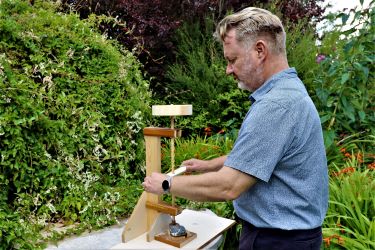 |
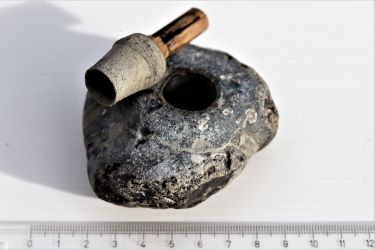 |
In addition to drilling, it was also possible to demonstrate that a series of elongated concave facets, of a type similar to those on the surface of the Knowth and other maesmor-type maceheads, could be ground into the surface of a flint nodule. This was achieved with the use of a fixed-horizontal-axis rotating wooden wheel with a water-suspended abrasive paste applied to its edge – a specialist technology of a type used in crystal glass cutting, but which is otherwise unknown in a prehistoric context.
Additional wheel grinding experiments using wooden wheels with an applied water-suspended quartzite paste were conducted in 2023. A bow-driven device designed to turn the wooden cutting wheel back-and-forth, in an alternating clockwise/anticlockwise rotation, similar to a pole lathe was also constructed for the purposes of further experimentation. Again, the results proved to be very promising.
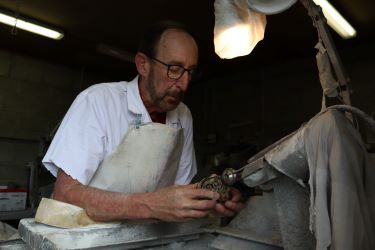 |
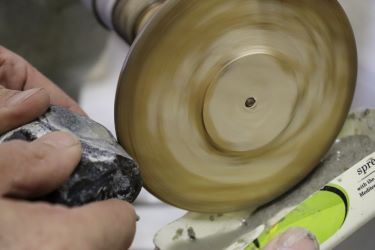 |
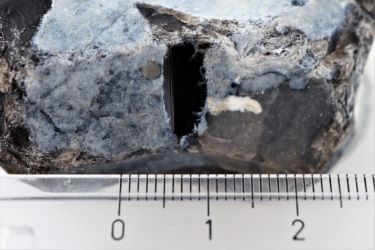 |
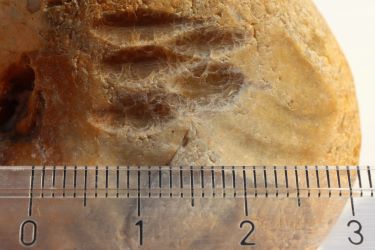 |
Some limited exploration of flint polishing on a sandstone polissoir and also a wooden-block polissoir using a quartzite grit as an abrasive was also investigated. While the sandstone was largely ineffective the wooden equivalent proved to be relatively efficient for the task.
Attempts to grind facets into the surface of a flint nodule using a straight-edge abrasive tool had mixed results. It did demonstrate, however, that it is not possible to carve or grind a curved line onto a flat or concave stone surface using this method. This provides some additional pausability to the hypothesis that abrasive wheels of various size and profile were required to apply some of the decorative motifs to the Knowth macehead. Experimental work continues ...
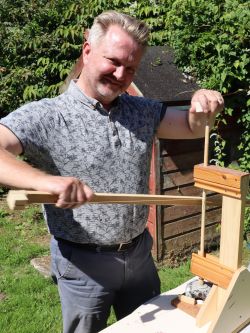 |
 |
-250.jpg) |
 |
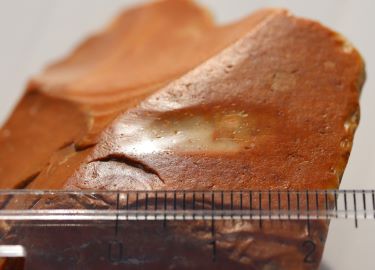 |
Further reading:
Fenwick, J. 1995 The manufacture of the decorated macehead from Knowth, county Meath. Journal of the Royal Society of Antiquaries of Ireland 125, 51-60.
For related research see: 'The Brú na Boinne Research Project'
This research project entitled 'Crafting the Knowth macehead: an experimental exploration of a unique Neolithic artefact' was awarded an Archaeologial Research Grant through the Royal Irish Academy (RIA) in May of 2022.
 |
 |



















